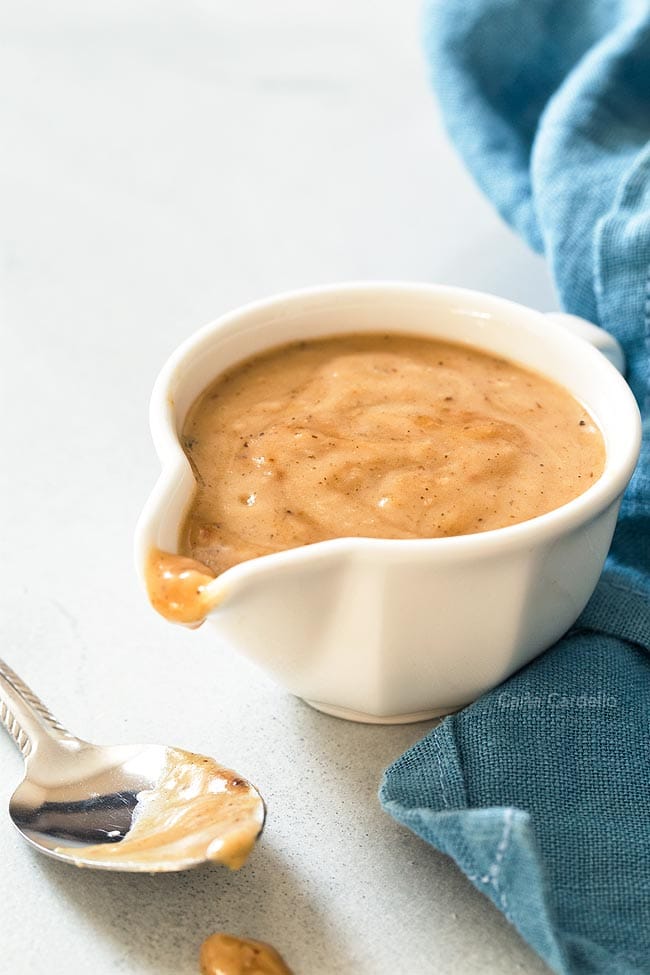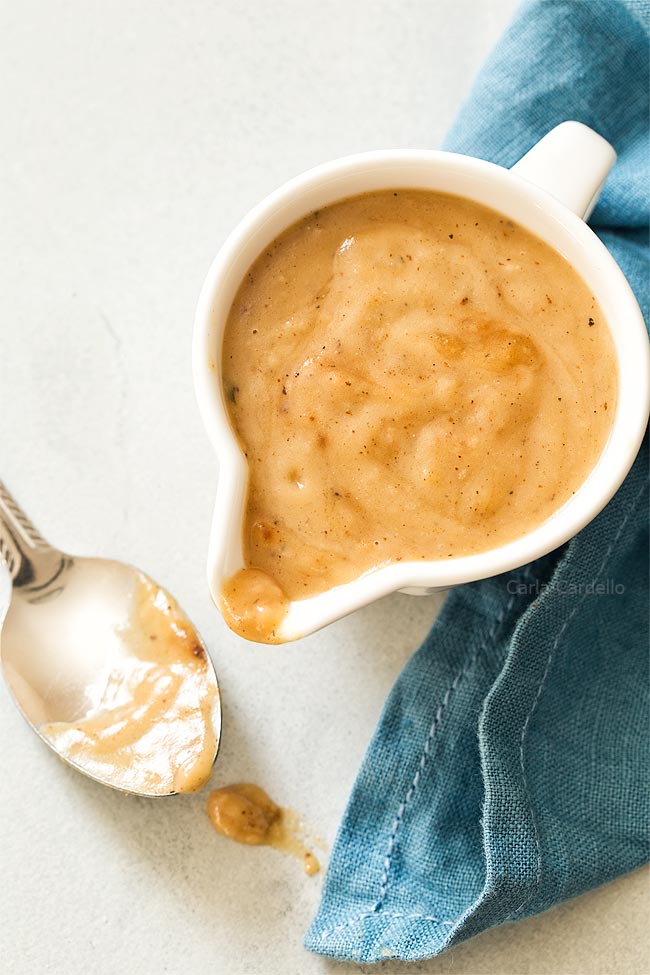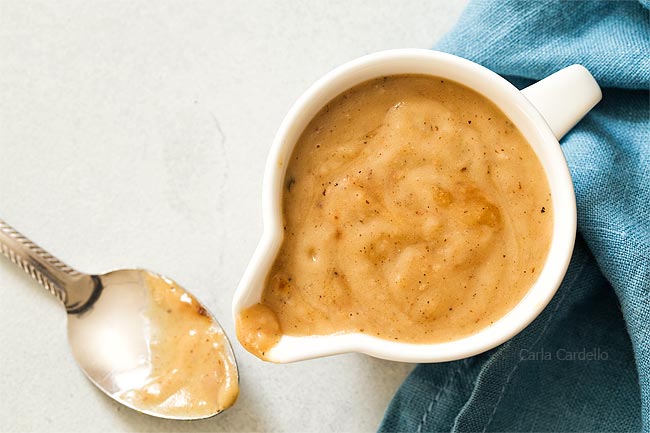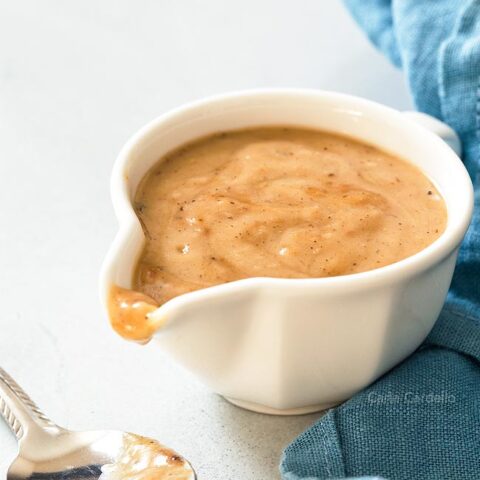Gravy From Drippings
Don’t know what to do with pan juices? Learn how to make gravy from drippings so you can make an easy from scratch sauce for your roasted meat. Make it for Sunday Supper or for holiday dinners.

The whole foundation of my blog is to make recipes from scratch. That means no packets or mixes.
When I see someone use a gravy packet, I die a little inside. Don’t they know how ridiculously easy it is to make homemade gravy?!
Many of you agree because my homemade Gravy Without Drippings and Mushroom Gravy are popular.
However, what do you do when you DO have meat drippings?
Luckily for you, I’m sharing my go-to Gravy From Drippings.
When I made my Small Pork Roast, I had drippings leftover in the pan.
Being the resourceful cook I am, I made some delicious small batch gravy.
Rather than trying to cram all of my knowledge about making gravy from drippings into one long post, I decided to post the pan gravy recipe on its own.
This guide is helpful for those who find themselves with meat drippings leftover and wondering what to do with them. You know you shouldn’t throw it away but don’t know where to begin.
Maybe you need a quick gravy for your Thanksgiving Dinner For Two, Christmas Dinner For Two, or even Easter For Two.
Or maybe your recipe tells you how to roast your meat but doesn’t tell you how to make gravy from drippings. Now you’re on the internet looking, which brought you here.
Don’t forget your mashed potatoes for two or biscuits and gravy for two!
Whatever the reason, I got you covered on making gravy from drippings.

What is pan gravy?
Pan gravy is a sauce made from meat drippings left behind in the pan. Drippings refer to the seasoned but not thickened juices extracted from the roasted meat.
You don’t want to throw away these fat drippings because there is so much flavor in them.
When you think of gravy, you often think about turkey gravy from drippings like with my Stuffed Turkey Breast, but you can also have chicken, beef, and pork drippings (which are delicious in sausage gravy recipe for 2).
Ingredients For Gravy From Drippings
To make this gravy recipe with drippings, you’ll need the following ingredients:
- Pan drippings: Comes from roasting your meat
- Butter: You may not have enough drippings, so you’ll need to additional fat.
- Flour: Thickens your gravy by making a roux. You can also substitute cornstarch.
- Broth: Use broth that complements your meat (chicken broth for chicken and pork, beef broth for beef and lamb)
- Milk: Adds some creaminess
- Salt: The amount used will be determined by how salty your drippings and broth are

How To Make Gravy From Drippings
The best way to make your gravy recipe with drippings is to make it directly in the roasting pan. This allows you to scrape up all the good brown bits left behind from the meat, known as fond.
This means placing the roasting pan directly on your stovetop burner. Use a wooden spoon or rubber spatula so you don’t scratch up the bottom of your pan.
If you don’t want to (or can’t) heat your pan on the stove, transfer everything to a skillet and make it in there.
If you made my Instant Pot Pork Roast with Vegetables, you’d make your gravy directly in the pressure cooker.
Here’s how to make gravy from roast juices:
- Melt the fat from the drippings and butter directly in the roasting pan, scraping up any brown bits left in the pan.
- Stir in the flour to form a roux and cook for 1 minute or until lightly brown.
- Slowly whisk in your broth. Bring to a boil then cook until it starts to thicken.
- Stir in the milk. Taste and add salt as needed.
How To Make Gravy With Cornstarch
Sometimes you don’t want to make pan gravy with flour. Perhaps you are looking to make a gluten free gravy.
You can easily make gravy using cornstarch, but the process is slightly different than using flour.
Instead of making a roux, you make a quick slurry of water and cornstarch. Stirring in a slurry ensures your gravy isn’t lumpy.
If you added dry cornstarch the same way you do with flour, you’d be left with lumps.
Stir the slurry into the hot fat then stir in the broth. Bring to a boil. Once it starts boiling, the gravy should thicken up.
How do you separate fat from drippings?
Normally if you have a large amount of drippings, you want to separate the fat before making gravy.
You can do this by transferring the drippings to a measuring cup and let sit for about 15 minutes or until the fat rises to the top. Skim off the fat with a spoon.
If you have the time and can let it sit overnight, the fat will actually solidify, making it so much easier to skim.
Add this fat to your pan for your gravy base. Add enough butter to equal the amount of fat called for in the recipe.
Since I focus on recipes for two, sometimes the amount of drippings is small.
I had about a tablespoon or so of drippings left in the pan from my small pork roast. With an amount so small, I didn’t skim off the fat. Instead, I added everything to the pan along with some butter.
Had I been making a larger meal, such as turkey for Thanksgiving, then I would take the time to skim off excess fat from the drippings.

Gravy From Drippings
Learn how to make gravy from drippings so you can make an easy from scratch sauce for your roasted meat. Make it for Sunday Supper or for holiday dinners.
Ingredients
- Pan drippings from roasted meat
- Up to 2 tablespoons unsalted butter
- 1/4 cup all-purpose flour* (see Note to substitute cornstarch)
- Up to 1 cup broth or stock, any flavor to match your meal
- 2 tablespoons whole milk
- Salt, to taste (preferably kosher)
Instructions
- Place meat drippings in a measuring cup and refrigerate 15 minutes.
- Skim 2 tablespoons fat off the top and place in roasting pan. Discard any remaining fat. If you don't have enough, add enough butter to equal 2 tablespoons total fat.
- Add enough broth to the liquid drippings to equal 1 cup.
- On the stovetop over medium heat, melt the fat and butter in the roasting pan, scraping up any brown bits left in the pan.
If you can't use your roasting pan, transfer everything to a skillet. - Stir in the flour to form a roux (paste) and cook for 1 minute or until lightly brown.
- Slowly whisk in the liquid drippings mixture. Bring to a boil then cook until thickened, about 3-5 minutes.
- Remove from the heat and stir in the milk. Taste and adjust for salt.
Gravy will thicken as it cools. If this happens, reheat and stir in a little bit of broth to thin it out if needed.
Notes
- Don't want to use flour? Stir together 1 tablespoon cornstarch and 1 tablespoon water in a small bowl then add to the melted fat in the pan.
- Need drippings? Make my Small Pork Roast.
- Don't have drippings? Check out my recipes for Homemade Gravy Without Drippings and Vegan Mushroom Gravy.
This post may contain affiliate links. As an Amazon Associate and member of other affiliate programs, I earn from qualifying purchase.


I just wanted to tell you that these instructions worked perfectly and the gavy made the meal! We had it over chicken.
Oh wonderful! Happy to hear that.
I have not made your recipe, yet, but have my roast in the oven now. My mother used to make her gravy similar to this, but I never knew exactly what she did. My siblings and I along with our families always met at her house for Sunday dinner, as our families got together every couple of months. She would have everything cooked and ready by the time we all got there, so we never knew exactly how she made it, but her gravy was always to die for! She passed away from cancer in 1990 and none of us girls ever got her exact gravy recipe before she died and none of us have ever been able to duplicate it. I’m hoping this is what we’ve been looking for all these years! I will keep you posted. Stay tuned!
Thanks for sharing your story! How did the gravy turn out?
I have to know how it compared!?!?
Excellent instructions. Some recipes don’t distinguish between the drippings and the fat.
Thanks, Elizabeth!
Thanks for sharing your knowledge with us. I have made several attempts at gravy to varying degrees of disaster.
I’m going to try your method but I have a couple of questions. Your instructions say to use equal parts fat and flour for the flour recipe but what are the proportions for the cornstarch recipe? Also, how much cornstarch to water for the slurry?
It’s in the recipe footnote. “1/4 cup all-purpose flour* (see Note to substitute cornstarch)” “*Don’t want to use flour? Stir together 1 tablespoon cornstarch and 1 tablespoon water in a small bowl then add to the melted fat in the pan.”
This recipe doesn’t scale. I tried doubling it and it was about as thick as mashed potatoes. I had to add an additional cup of broth to thin it back out, at which point the flavor was significantly diluted. I plan to make the same amount of roux but use two cups of liquid(drippings and broth combined).
The recipe does scale, so I’m not sure what happened with your gravy. Perhaps you didn’t have enough drippings when you doubled?
Use this recipe but I used bobs red mill gluten free 1 to 1 flour since we’re all Celiacs. I also used soy milk, turned out great.
Glad it worked for you! Thanks for sharing the feedback for others who also need to make these substitutes.
What can you substitute.for Man that does not . like potatoes of any kind.? Not even sweet potato
I’m having a hard time deciding on what to use in it’s place for Thanksgiving sense it’s going to be just us two this year..
I would like to say that you have .are so easy for two empty nesters to eat. When you used y cooking for five for twenty years it makes hard to cook .for just two
Your recipes have help me out lots of times .
Thank you ever so much. And my god bless you
Glad my recipes are helping you out! You can use another root vegetable, such as parsnip or turnip. However, if he won’t eat those you can also try cauliflower or carrots.